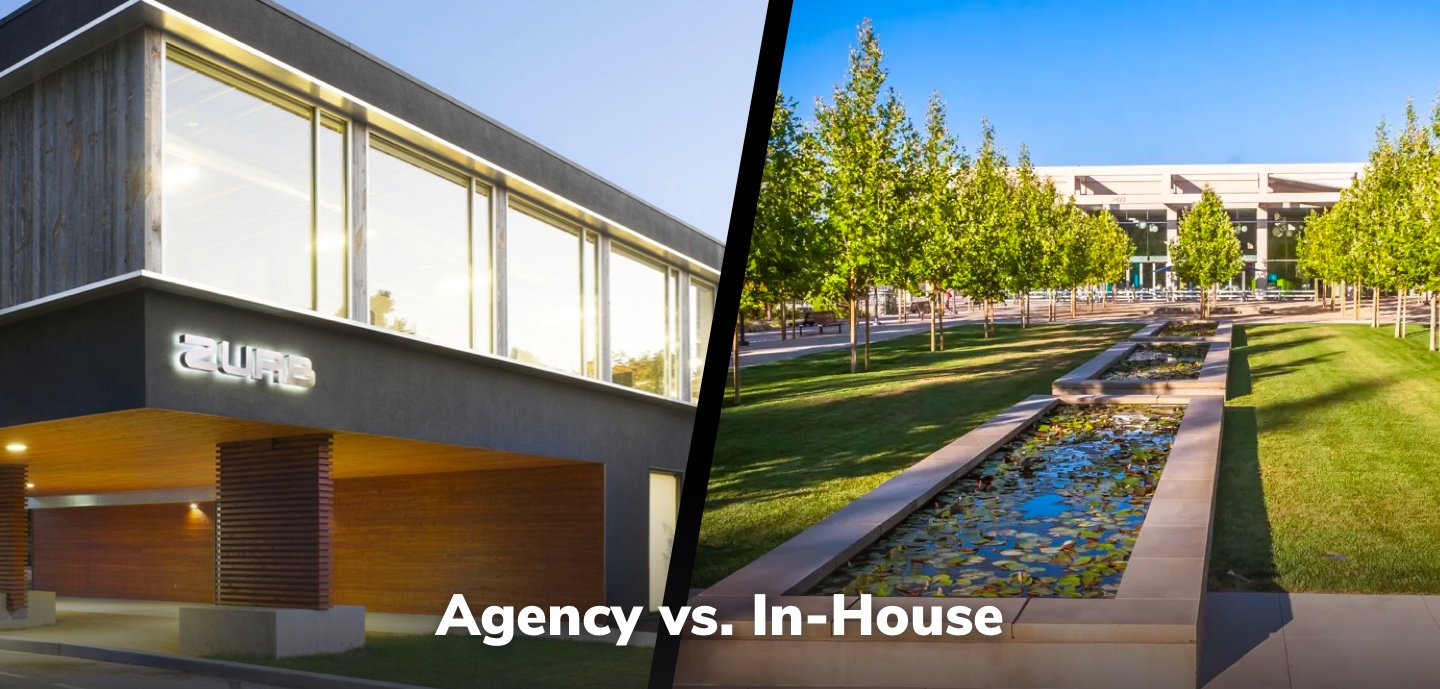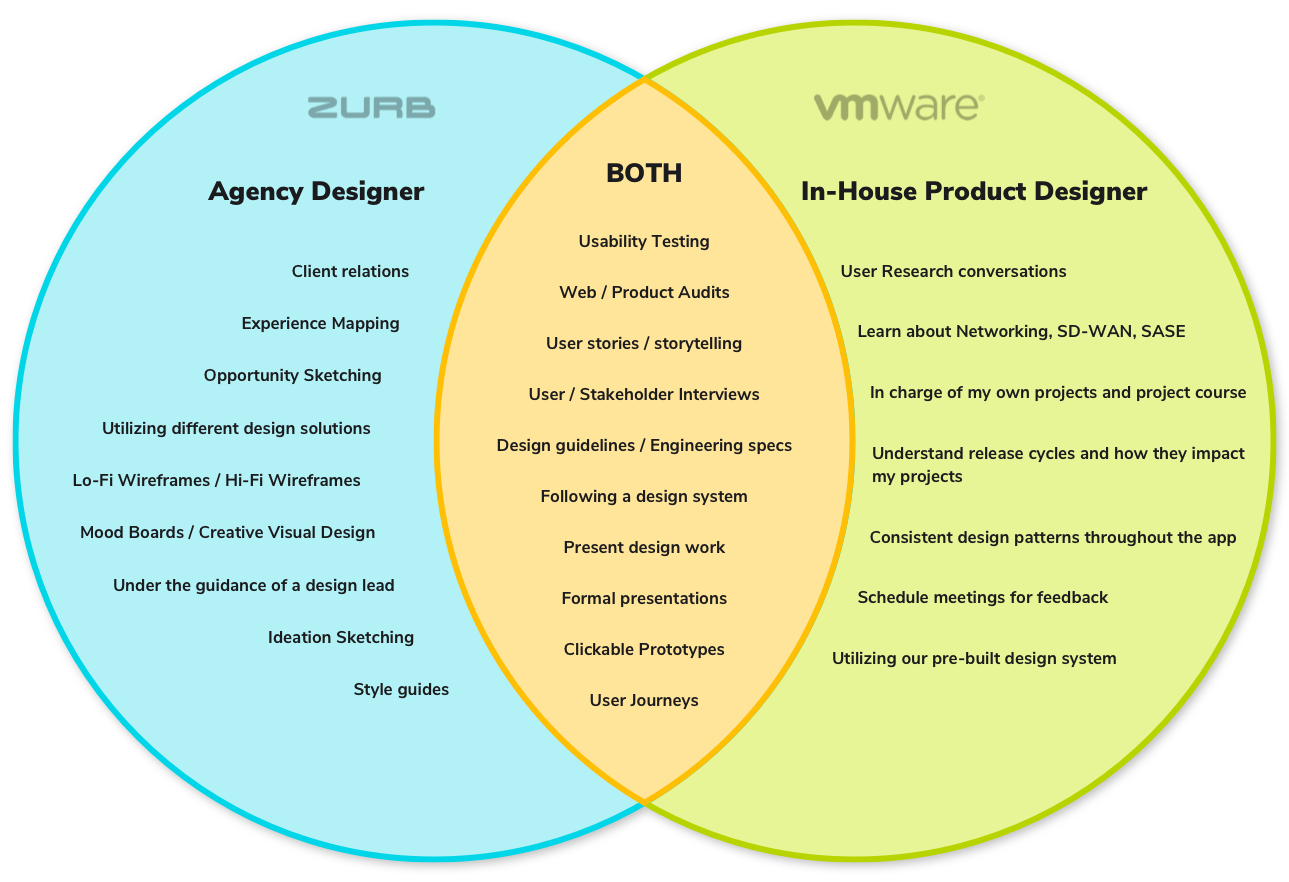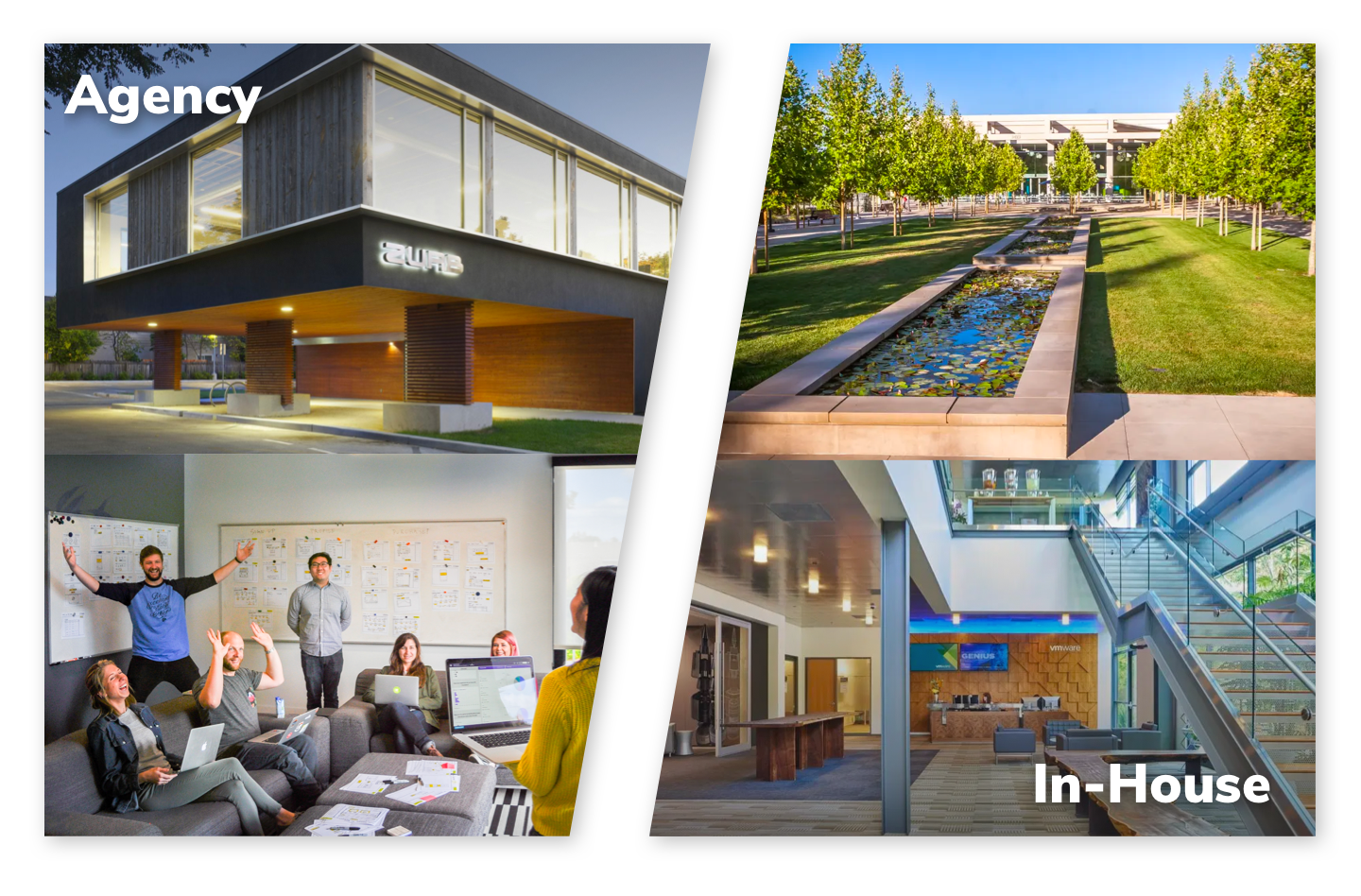

I’ve been working in the industry for about 3 years—so just barely scratching the surface of design knowledge and experience. For 2 of the 3 years, I was a Designer at ZURB, a small design agency (15 employees) in Campbell, CA. And now I’m coming up on my 1 year as a Product Designer at VMware (35,000 employees) located at the headquarter campus in Palo Alto, CA.
A few weeks ago, I was challenged at work to take a step back and reflect on the differences between these two experiences—agency life vs. the in-house corporate enterprise world. And here’s what I’d like to share!
Before hopping into each one of these sections I’d like to lay out the similarities and differences between my responsibilities at these two jobs.

So to recap, ZURB = Agency. VMware = In-House.
At ZURB, I was following the Design Lead’s guidance. The Design Lead was in charge of setting up client meetings, giving the designer feedback, and overall guidance on where the project is heading each week. As the Designer, I focused solely on the design work and solutions for the client, presenting to the client each week and summarizing what we learned and what we’re doing next. It was always heads-down, go go go, 24/7. I felt secure, knowing that the Design Lead always had my back and was always there to say what we would do next.
Now with VMware, I’ve had more project ownership and decision-making. I decide what I want to do each week for projects and what I want to present and get feedback on to complete the project. I spend more time designing in phases and thinking and planning for releases, and how my project is affected or affects other projects or pieces of the app. With Enterprise you need to take a step back all the time—there’s more big picture thinking.
I view Agency design as having tunnel vision into one part of the client’s company or even just into one part of the client’s app. I never really had the time to fully understand the entire product experience.
Whereas now I’m juggling a lot of different components. My job is to think about and understand the entire experience of our app (from unboxing our hardware, understanding the UI workflows of our app, to online documentation, to even some marketing aspects).
At ZURB, everything felt so rushed. Yes, I interviewed clients about the app/product and how it could be improved and a handful of times got to speak to customers—and like all user research, there could always be more. The amazing part of working at ZURB was the priority of user research or “advocacy”. For every project, I had a User Researcher on my team constantly growing our understanding of the audience and putting my designs in front of potential customers. This was great and super helpful but still because of the agency vibe, was always extremely rushed.
At VMware, there’s more time for real customer feedback and implementing customer feedback along the way. I love this! Yes, things run a bit slower, and because they run slower it allows time for me to ask a Product Manager to set up a time for a customer call, have an hour-long conversation with the customer clicking through my prototype, and time to document/implement the customer feedback.
With agency, the ones we had to get consensus from and “sell the design solution” to, were the clients. And they were pretty open to what we were doing and what we had to share because they were paying us.
It’s been a bit more challenging getting consensus with Enterprise. I’ve had to expand my tactics to further explain what I did for the product and why the design decisions were made — how they will positively impact the product. Part of my job is marketing my abilities to my team (team of Engineers and Project Managers) and showing them how important design is to the product.
Agency was very much focused on design. Design was the heart of everything we did—the shining star of every project. The CEO of ZURB wrote articles, methodologies, and doc upon doc outlining our structured design process. ZURB is known in the Bay Area as being a design boot camp and every designer there has memorized our structure and sees first-hand how effective it is.
Now at VMware, I see how engineering takes the forefront (with a team of 400 Engineers for our 1 product) and design takes a backseat (with a team of 4 designers for the same 1 product). Meeting after meeting my job includes selling why design is necessary for features and projects and why I need to be involved with the feature that is being built for our app.
This has opened my eyes that design is not the only aspect of a fantastic product. Designing for VMware’s products has given me a realistic view—our products are practical and technically complex meaning that I need others’ expertise and input.
At ZURB, most of the projects were visionary. I would spend 6 weeks creating an MVP of the app, hand it over to the clients, and hope that they get funding, take their engineering team, and implemented the designs. Sadly, about half of the designs stayed internal and rarely reached the customer’s hands. And the moments you did see your work live on a website, were huge wins!
Now at VMware, I work super closely with the engineers that are implementing my designs. I get on 1:1 calls with the engineer to see the code demoed and tell them what to change and how the UI interaction should behave. I have so much more control over how the design gets implemented. I’m constantly reviewing JIRA and GitLab tickets and making bugs on what should be fixed in the product. And I’m seeing the launch of my designs release after release and used by over 100,000 customers worldwide. Still a win, just a different type of win than ZURB.
With agency, I was riding solo, and I really didn’t mind it too much. It was one designer per project, so I really didn’t have to collaborate with other designers (besides getting feedback from the Design Lead and other designers). Every 6-8 weeks you were back at square one. Which was kind of nice, a fresh start. But it also meant, a new client, a new product to understand, a new design system to create or follow, a new set of wireframes to start from scratch. At times, it was exciting to research and learn about a new client/industry. And at other times, it felt tiresome and rushed to not have the opportunity to dive into the project problem as much as I would have liked to.
Now at VMware, there’s just one product I design for, one company’s business strategy to understand, giving me that extra time to really dive into the ins and outs of the app. Yes, this app is growing and changing and there will always be new features, new services, and new personas I’ll need to learn about—so still refreshing and keeping the brain moving.
Since it’s one app, we can work more quickly by utilizing our pre-built design system with components, templates, and patterns already set in place. I also work together more with the other 3 designers because our designs can impact one another's and we need to be more aware of what each other is doing to build a cohesive experience.
At ZURB, heck yeah I was given creative freedom. My favorite was taking 2 weeks to design our holiday card and update our marketing website—it for sure re-energized me. With almost every project I got to take the lead in setting the mood of the app or website, creating the brand, color palette, typography, iconography, and imagery. And then implementing the chosen mood into a few mockups. This creative direction phase was one of my favorites!
At VMware, long gone are the days scrolling through Dribbble for inspo while at work.VMware has a design system, Clarity, that all VMware designers follow and implement into all VMware products. However, there are still nuggets of opportunity with error states, empty states, or a few hours spent to design our corporate t-shirt!
Since working at VMware, I’ve been using my weekends more to recharge my creativity through hobbies like painting and sewing and side projects like my podcast.
Both ZURB and VMware have given me time and resources for career development. With ZURB however, it seemed that I was always too stressed with client projects to really have the opportunity to step back and process my career track or actively work on some of my goals.
VMware has been very supportive with giving time to discuss short-term and long-term career goals. They also have a ton of resources for what I need to achieve to get a promotion and work my way up the design tiers—which I love that structure.
Because of the lessoned stress with VMware projects, this opens up for more time for learning. If I need to take 2 hours to research IPv6 then I have that project flexibility to do so. If I need to watch a Figma auto layout tutorial or want to attend a design thinking webinar in the middle of the workday—I totally can. In fact, my manager encouraged me to take an hour a day to dedicate to learning.
At ZURB, we didn’t have this “dedicated time” set aside to learn. A ton of my learning came from projects and hours of listening to my Design Leads. I still walked away from ZURB having learned SO much!
My roommates and boyfriend can testify that I was extremely stressed, overworked, and underpaid for all the hours I was putting in while at ZURB. There were 4 weeks straight that I logged 70-80 hours, I was asked twice to come into the office on a Saturday, and I pulled 3 all-nighters before a big deadline. ZURB later gave me a couple of bonuses for this crazy amount of extra time, but it still wasn’t fair. Having a break from thinking about work is important to one’s mental and physical health. It was draining and exhausting meeting demanding client deadlines every 2 days—with not enough time in the day to do the work that was being asked not only from me—but all designers at ZURB.
I can say with 100% confidence that working at VMware has been 10 times less stressful than working at the agency. If I need another 2 weeks to wrap up a project, just say the word, done. If I want to go for a run in the middle of my workday, done. If I log onto work at 7AM, I can start wrapping up work at 4PM. It’s extremely refreshing to have my evenings and weekends back and free from work. Maybe once a month I’ll work a bit later into the evening to prep for a presentation, but definitely a huge difference from ZURB.
We’re not supposed to talk about this…right…? How do we learn if no one talks about it? Not just salary but also benefits, 401K matching, days off (where you still get paid while you don’t have to work), and free stock! These things are huge and you should definitely be thinking about them.
Here's what I've been told:
Again, maybe this is not true, and of course depends on the company, industry, and job level—this is just from my experience, things I’ve read, and what I’ve learned talking to other designers.
Product design is not for everyone, and that’s ok. And life is not all about money. Be happy in what you do. I think part of being happy is having to not stress too much about paying bills, not stressing too much about work, and having time and money to travel, to visit friends and family, and to spend on life experiences.
It’s not all about salary—amazing benefits can compensate for salary. VMware has unlimited vacation days and gives us 1 random Friday off per quarter! This is huge! 4 random days off during the whole year, plus additional holidays off that I didn’t get off at ZURB (such as Presidents Day, Veteran’s day). With ZURB I remember planning out all of my precious vacation days that I had left for the year and figuring out how I could do all things I wanted to do.
Every summer at ZURB, we would have a boat trip day, we would stop work at 11AM, drive to Santa Cruz, and board a yacht for a day of drinking and then later go back to our CEO’s beach house where he would grill for us, and we’d continue drinking and playing games. Or a random Wednesday we would all stop work at 2PM and go to the movies together or go for a hike and burgers. Things like this—taking a break from work, having your company treat you to a good time, bonding with the team, making memories—were priceless.
This one is hard to compare because I’ve only been working remotely with VMware and have only met my co-workers in-person like once or twice. Yes, I have a zoom call once a week with over 300 people, so at times I do feel like a small fish in the sea. But the direct team that I work daily with includes about 10-15 people. I’ve gotten to know some of them pretty well, but I’m sure it will be easier when we are all back in the office together.
ZURB’s culture was amazing, everyone I worked with was extremely driven, we all got along great, and because it was such a small team—they really did become my family, people that looked out for me and genuinely cared about me. We all knew about each other’s personal lives, had each other on Snapchat, and hung out with each other after work and on the weekends. It was a super fun place to work, music constantly playing over the speakers, and everyone cracking jokes all the time. I just remember laughing so much, like crying laughing, and feeling like a valuable member of the team.

I wanted to write this to help those who are currently deciding what route of design to go down. I hope this enlightens you and please understand that this is just my experience.
I seriously loved ZURB and agency life—yes there were moments of exhaustion, late nights, frustration, and painful design cycles to push through—that may just come with every job. I sincerely do miss working at ZURB and all the amazing people I got to learn from.
I’m becoming more and more accepting and excited about the work that I’m doing at VMware. Reflecting back on the pros and cons of each I’m becoming more and more of a fan of enterprise design. Mainly because I love chatting with engineers as they build out my designs and it’s super exciting seeing my work live in code and then used by hundreds of thousands of users across the world.
If you have feedback or questions on this article or my experiences, please email me at hi@leahcallahandesign.com. Thanks!
To learn more about the post-grad design world—listen to my design podcast, Mile a Minute (co-hosted with Anna Oakes, Digital Designer at Lessonly)!